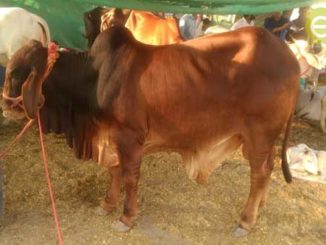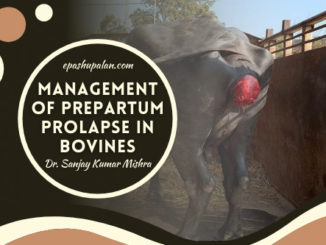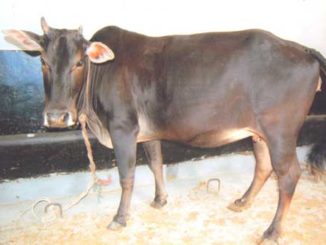Introduction
Planning, implementing and managing a replacement program is as important as the milking, feeding and reproduction management on a dairy farm. Better care and management of heifer will give high quality replacement stock to the dairy farm.
Rearing cows which have aborted, repeat breeders, have bad udder confirmation, structurally unsound, bad temperament, low productive, or suffering from any incurable disease will incur excessive loss to the farmer, and must be culled timely. Keep as long as the animal is productive and not likely to die or become problem and sell the animal in time frame of high value cull price. Culling is costly but failing to cull for fertility, structure, disposition, and productivity leads to creating greater problems in the future.
The average annual culling rate for dairy herds is around 20 percent, and replacement rate (20-25%) is generally kept little higher than this for gradual growth of the farm without causing excessive economic burden. Herd replacement contributes a significant cost in the dairy enterprise. Moreover, a primipara heifer’s first lactation will pay for its rearing expenditures rather than contributing in farm’s profit. The cost of replacements is typically second only to milk cow feed costs.
Replacement cost
The cost of raising a heifer from birth to calving is a sizable investment, it must be made sure that every animal being raised has the best chance of being profitable.
Let us assume a herd of 100 animals with variables A, B and C as:
A: Replacement female price (rearing price around Rs. 45,000; bought new replacements: Rs. 80,000); B: Cull cow price (Rs. 20,000), C: % of herd replaced (25%)
- If all animals are farm reared, replacement cost= (A-B) *C = (45,000-20,000) X 25= Rs. 6,25,000 in a herd of 100 animals
- If all animals are purchased = (80,000-20,000) X 25= Rs. 15,00,000
- 50% reared (12.5)+50% purchased (12.5) = 25,000 X 12.5 + 60,000 X 12.5 = Rs. 10,62,500
Farmers are aware that heifer rearing is expensive, but they still keep almost all the newborn heifer calves to ensure enough young stock are available to replace culled dairy cows. When too much young stock is kept, they are sold.
Replacement strategy
Number of heifers required depends upon the goal for the herd replacement program. The goal can be expanding the herd or to sell extra heifers for supplemental income or simply to maintain the herd size.
- Purchase young bred females from outside
- Retain heifers from own farm that are developed and bred for herd replacements
- Herd maintenance: Maintain static herd size by replacing culls with a constant replacement rate.
- Herd reduction: Allow herd to reduce under high cattle prices by low replacement rate.
- Herd expansion: Expand herd under by retaining greater numbers for breeding.
Raising and Buying
To obtain herd replacement stock, two options are available with the farmers, i.e. raising them himself or purchasing from outside. He should decide based upon investment, comfort, profit, available farm facilities, availability of good replacement stock for purchase, health situations outside the farm, etc.
Raising heifer on farm provides greater opportunity for information so we can expect more accurate selections for genetic improvement. It will become easy to implement programs like progeny testing for herd sires. It further minimizes unfavorable permanent non-genetic effects (permanent environment effect) producing a better adapted stock. We can check for biosecurity, there are minimal chances of introduction of new foreign infections in the herd. Extra profit can be generated by selling out the surplus heifers. Main disadvantage of this method is that it leads to more investment without immediate profit for 2-3 years. The uncertainty in the availability of full-grown heifers occurs due to mortality and growth and reproduction problems in the rearing period.
Purchasing is beneficial when exceptionally good stock is available easily. Farmer does not have to wait longer as immediate returns will start coming as soon as the heifer reaches AFC. Buying a better genetic merit bull or AI from the one having better breeding value than our herd’s average will provide immense potential for genetic improvement in subsequent generation. It will maximize heterosis and complementarity. Buying heifer will eliminate the need to include certain traits like calving ease and we can focus solely on genetic improvement for production. We can use all the good quality pasture and feed resources for income generating cows rather than spending it on heifer rearing. Purchasing sources can be government or private dairy farms, university or institutional farms, milk colonies, breed societies, animal fairs and scientifically running Goshalas, Gosadans and Pinjrapoles.
Factors to consider while selecting replacement heifers
- Positive genomic profile: Check pedigree of the heifer. It should be sired by high genetic merit bull and from a recognized farm maintaining cows similar to our herd. Further, the sire must have scored well in breeding soundness evaluation.
- Age: Date of birth should be checked and age should not be more. It should have attained puberty at early age and body weight should be 2/3rd of the adult cow of the particular breed.
- Birth weight and size: Birth weight and size should be moderate, neither high nor low.
- Temperament: Heifer should be docile and easily manageable.
- Genomic testing: Presently its being done at research level but in near future commercial herds and rich farmers may go for genomic profiling for economic traits.
Heifer development for replacement stock
The primary objective of a replacement program in dairy herd should be to shift the heifers into the milking herd as quickly as possible. This ensures that the maintenance cost is minimized, there is the earliest possible return on the investment and that the heifer can produce well during her first lactation.
Heifer development should not be neglected. Evaluate, identify and develop heifer into cows which will provide more profit. Ideally they should be the daughters of elite dams and proven sires, but most of the times such records are unavailable, so the farmers need to go for other factors like body condition scores, dam’s yield, freedom from diseases, structural soundness and average daily gain (ADG). One should never underestimate the value of heifer development on the profitability of the herd. Breeding undersized animals is never profitable. Undersized heifers have more calving problems, produce less milk, have greater difficulty getting back into calf and compete poorly with older cows for feed. For the heifer the calving is first time and it may have difficulty in calving, so take extra care during calving. Animals lagging behind below the required standards should be removed from the herd. Because they are still growing, heifers will use some of their feed for growth rather than for producing milk and are more likely to be culled for poor milk yield and/or infertility.
One of the most important factor influencing the cost of heifer replacements on a dairy farm is the age at first calving (AFC). Lesser the AFC, sooner the heifer will start giving profit, lesser the farmer has to spend on maintenance cost of the heifer. Poor growth and reproductive problems greatly reduces the number of heifer calves reaching AFC because these heifers have a higher probability to get culled otherwise there will be delayed availability for replacement, causing unnecessary economic burden. Achieving early AFC also greatly depends upon the nutrition and weight gain of the animal, so we need to maintain a higher ADG per day. But, attempting to get a heifer to grow faster than the upper limit has proven to be counter-productive in udder development and lactation. Age at first conception for zebu ranges from 25-28 months, for crossbreds around 21-23 months and 30-35 months in buffalo. Target weights and body size must be achieved timely.
Conclusion
Every heifer calf born on the dairy should be looked at as a future source of revenue, either as a milk producer or as a herd replacement for another farm. Dairy replacements are, at the same time, both costly and valuable. Getting the heifers into the milk barn at an earlier age saves in long-term replacement costs, as well as getting more cows into the milking herd, which is the main objective.






This site was… how do you say it? Relevant!! Finally I’ve found something which helped me. Cheers!